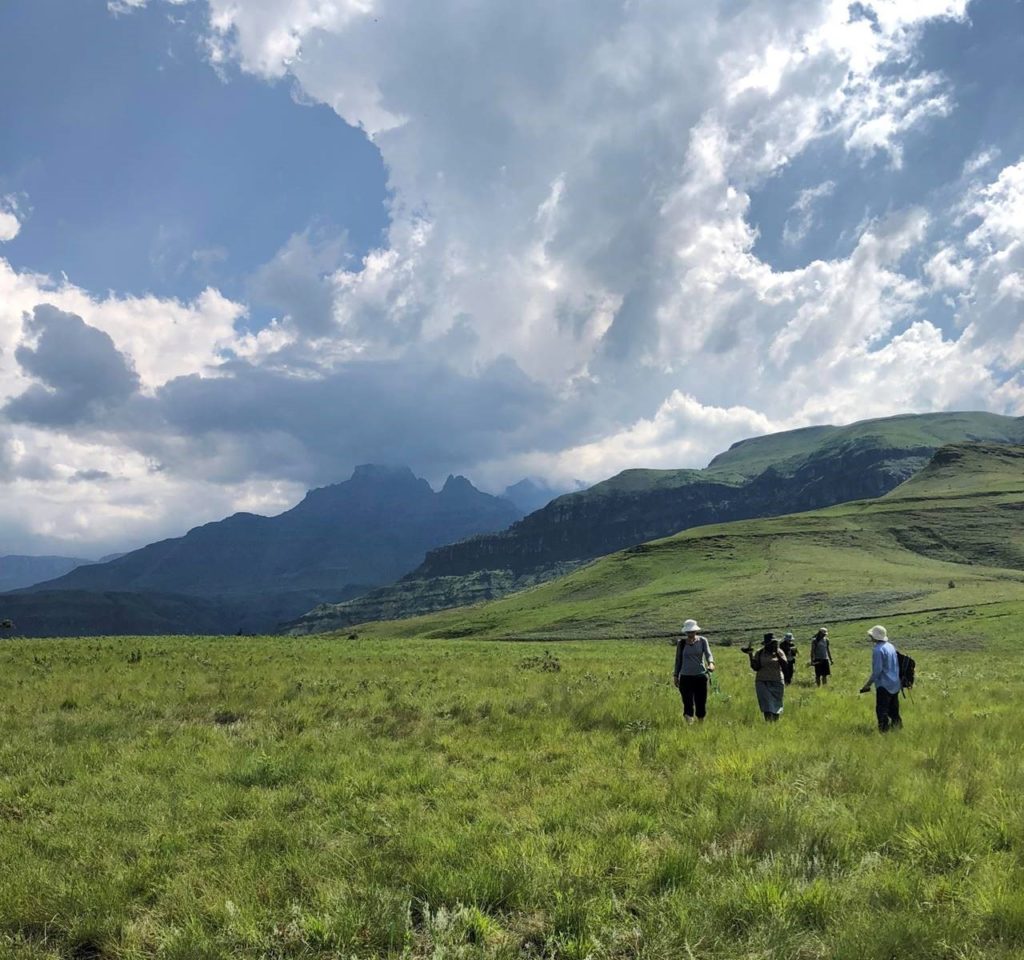Exploring open ecosystems through a lens of environmental and social justice.
Dr Caroline Lehmann describes her research as a “bridge between evolutionary and ecological science to understand the dynamics of grassy ecosystems across the world.” Her work explores how the traits that shape life history strategies in plants cascade to impact the dynamics of ecosystems and biomes with results that, in an era of radical change, have significant implications for environmental policy.
Sparking curiosity
Caroline’s interest in nature was kindled during her childhood in Australia. A self-confessed geography and natural history ‘nerd’ with a particular passion for fossils and plants, as a teenager she found that the 1994 Sydney bushfires focused her burgeoning interest. “It was terrifying – fires encircled the city”. Yet just weeks later, when a family friend and botanist took her on a bushwalk, “Everything was resprouting,” Caroline recalls. “I realized it was part of a bigger process”. This led her to a high school project on post-fire flowering in grass trees (Xanthorrhoea spp.) and an undergraduate degree in Palaeontology and Biology.
A variety of scientific and non-scientific roles followed, including doctoral studies based in Kakadu National Park – a 20,000 km2 landscape in the Northern Territory managed jointly by the Bininj and Mungguy Aboriginal communities and Parks Australia. In this relatively remote part of the world, Caroline studied multi-decadal landscape change and began to learn more about the diversity of knowledge systems and the links between biology, colonization and dispossession, inciting a determination to ensure that local communities are respected as central to research and conservation in her work across the tropics. She is adamant that, “Nations and people that did not create the climate crisis should not be made to bear its solutions”.

Linking the local to the global
Understanding the fundamental nature of ecosystems is vital to developing socio-ecologically appropriate land management strategies, both on a local scale (such as the importance of fire and animals to maintaining ecosystem health) and globally (for instance recognising where it is, and is not, appropriate to plant trees). For grassland and savanna, historical misrepresentation as degraded habitats created by anthropogenic processes underpins significant under-appreciation of their importance to biodiversity, carbon storage and diverse human cultures. These biomes are now threatened both by global change and by our attempts to mitigate that change through tree-planting.
Such complex questions require multiple methods of research, from evolutionary analysis to ecological experiments, remote sensing to hands-on ecosystem surveys. Studying more than 2,000 sites across Africa, Australia and South America, Caroline and her collaborators showed that the convergent structures of savanna ecosystems mask quantitative differences in the relationship among ecosystems, climate and fire. These differences, underpinned by the varied evolutionary and environmental histories of three continents, also likely influence future ecosystem responses to climate change, with implications for carbon storage.
In an exciting new initiative, Caroline is a founder of OpEN – the Open Ecosystems Network, a mechanism for sharing cutting-edge research into savannas, grasslands and shrublands with the public and policymakers. She also currently leads the ‘fire management’ work programme of a six-year Defra Biodiverse Landscapes-funded consortium project for Madagascar aiming to co-create community-led fire management in tandem with developing a new understanding of the interconnections among fire, biodiversity, carbon and people on the island. And, with a large cohort of PhD students, Caroline loves to teach – her passion, she says, is “facilitating others’ journeys and helping them build connections.”
All about action
Looking forward, a crucial challenge for biodiversity scientists is translating research into action, something Caroline believes can only occur via a combination of binding targets and meaningful local initiatives: “Global aspirations are unachievable if they don’t take into account local ecology and communities. Communities must be engaged and empowered to take actions appropriate to their situation,” she says. The economic impetus needs to come from those wealthy countries that are historically responsible for environmental damage, “but communities usually know what they need to solve it”.
Tree planting is a particular concern, threatening to do far more harm than good in the savanna ecosystems that Caroline champions. For Madagascar in particular, the outdated concept of grasslands as anthropogenic systems puts the entire landscape under threat. Writing in 2021 with Cédrique Solofondranohatra from the Université d’Antananarivo and Maria Vorontsova at the Royal Botanic Gardens, Kew, she explained, “Grassy ecosystems have been interpreted through colonial lenses and in utilitarian terms that have impacted ecological research and understanding,” potentially leading to misguided conservation priorities, policies and attempted climate change mitigation by tree planting. “The antiquated colonial vision of a pristine and exotic pre-human Madagascar paradise needs to give way to a nuanced realistic understanding of socio-ecological systems led by Malagasy scientists.”

Dr Caroline Lehmann is Head of Tropical Diversity at the Royal Botanic Garden Edinburgh and Reader in Biogeography at the University of Edinburgh. Her work is supported by Scottish Government’s Rural and Environmental Science and Analytical Services Division, the Royal Society, NERC, Defra, the Darwin Initiative and Oppenheimer Generations Research and Conservation. Find out more here.
This post is part of a series showcasing Scotland’s innovative, high-impact research supporting biodiversity conservation, in partnership with Scottish Government and NatureScot. Read the rest of the series here.
Further reading
Lehmann, C.E.R., et al. 2011. Deciphering the distribution of the savanna biome. New Phytologist 191(1):197—209. https://doi.org/10.1111/j.1469-8137.2011.03689.x
Lehmann, C.E.R., et al. 2014. Savanna vegetation-fire-climate relationships differ among continents. Science 343(6170): 548—552. https://doi.org/10.1126/science.1247355
Parr, C.L., et al. 2014. Tropical grassy biomes: misunderstood, neglected, and under threat. Trends in Ecology and Evolution 29(4):205—213. https://doi.org/10.1016/j.tree.2014.02.004
Parr, C. & Lehmann, C.E.R. 2019. When tree planting actually damages ecosystems. The Conversation. https://theconversation.com/when-tree-planting-actually-damages-ecosystems-120786
Lehmann, C.E.R., Solofondranohatra, C.L. & Vorontsova, M.S. 2021. Beyond ancient versus anthropogenic for Madagascar’s grassy ecosystems. A Reply to: Crowley et al. (2021). Proceedings of the Royal Society B 288(1950):20210388. https://doi.org/10.1098/rspb.2021.0388
